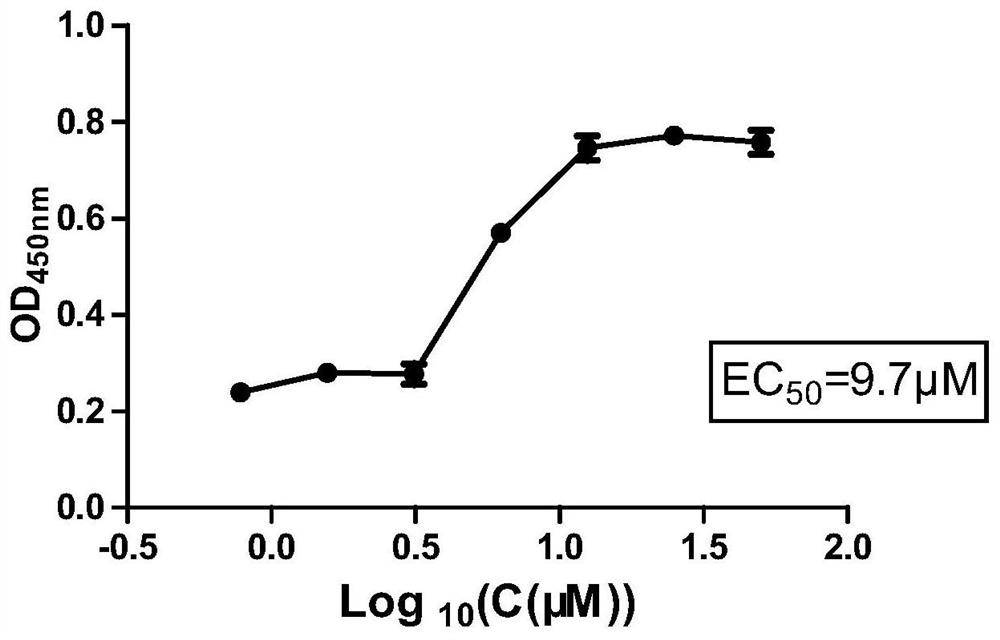Application of sulfamethoxypyrazine in preparation of product for preventing and/or treating bovine parainfluenza virus
A technology of sulfamethoxazine and bovine parainfluenza virus, which is applied in the fields of cattle feed additives and bovine respiratory syndrome treatment drugs, can solve the problems of severe, decreased respiratory mucosal defense ability, increased mortality and other problems, and achieves the prevention of proliferation. Effect
- Summary
- Abstract
- Description
- Claims
- Application Information
AI Technical Summary
Problems solved by technology
Method used
Image
Examples
Embodiment 1
[0041] Example 1 Virus TCID 50 Determination of
[0042] MDBK cells (preserved by Dairy Cow Research Center, Shandong Academy of Agricultural Sciences) were digested and mixed with 1 × 10 per well. 5 Cells / mL were seeded into 96-well cell culture plates, placed in 37°C, 5% CO 2 After being cultured into a single layer of cells in a cell culture box, the cell growth solution in the well was discarded, and the virus dilution solution of BPIV3 serial 10-fold dilution (dilutions were 10 -1 ~10 -10 ) inoculated in a 96-well plate full of monolayer cells, 100 μL per well, placed in 37°C, 5% CO 2 Continue to culture in the incubator, observe the CPE of the cells day by day, and record the number of cells with pathological changes in detail. At the same time, a normal cell control group and a blank control group were set up, with 8 replicates in each group, and the results were judged when no further cell lesions occurred. The cell pathological well is the cell hole corresponding...
Embodiment 2
[0052] The toxicity experiment of embodiment 2 sulfamethoxine to MDBK cell
[0053] MDBK cells are susceptible to BPIV3. Therefore, the cytotoxicity of sulfamethoxine to MDBK cells was first detected, and the specific experimental steps were as follows:
[0054] (1) Inoculate 100 μL cells (MDBK 1×10 4 pieces / hole).
[0055] (2) After cultured to the MDBK monolayer, the next step of drug addition analysis was performed. Discard the medium, add 100 μL of 2% FBS DMEM containing different drug concentrations to each well, and make 3 parallels for each concentration. At the same time, control wells: add 100 μL 2% FBS DMEM medium. Zero well: no cells are plated.
[0056] (3) At 37°C, 5% CO 2 After culturing under the conditions for 48 hours, operate according to the instructions of the CCK-8 kit, and measure the OD value at 450nm with a microplate reader.
[0057] (4) 37°C, 5% CO 2 After culturing for 2 h under the same conditions, the absorbance was measured at 450 nm. A45...
Embodiment 3
[0060] Embodiment 3 Sulfamethoxine is to the inhibition experiment of BPIV3
[0061] (1) Inoculate 1×10 in each well of a 96-well plate 4 MDBK cells, 37°C, 5% CO 2 Cultivate overnight in an incubator;
[0062] (2) Discard the medium, add 100 μL of 2% DMEM to each well, and add the medicine according to the initial concentration of 50 μM, two-fold concentration gradient dilution, 5% CO 2 Culture in an incubator; after drug incubation for 2 hours, add 100 μL of 1000 TCID to each well 50 BPIV3 dilutions.
[0063] (3) After 48 hours, operate according to the instructions of the CCK-8 kit, and measure the OD value at 450 nm with a microplate reader.
[0064] (4) analysis data, virus inhibition rate (%)=(drug treatment group D450nm value-virus control group D450nm value) / (normal cell control group D450nm value-virus control group D450nm value) * 100%, get with GraphPad Prism5 software The half effective concentration of the compound (EC 50 )value. The result is as image 3 s...
PUM
 Login to View More
Login to View More Abstract
Description
Claims
Application Information
 Login to View More
Login to View More - R&D
- Intellectual Property
- Life Sciences
- Materials
- Tech Scout
- Unparalleled Data Quality
- Higher Quality Content
- 60% Fewer Hallucinations
Browse by: Latest US Patents, China's latest patents, Technical Efficacy Thesaurus, Application Domain, Technology Topic, Popular Technical Reports.
© 2025 PatSnap. All rights reserved.Legal|Privacy policy|Modern Slavery Act Transparency Statement|Sitemap|About US| Contact US: help@patsnap.com



